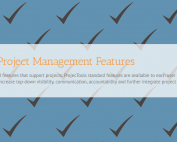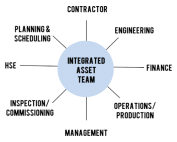Systems Completion and Construction Punch List
For groups managing construction and completions of large projects (Oil & Gas, EPC, Energy, Architecture) its massively important to organize and manage data effectively. When done incorrectly teams/inspectors end up sitting idle or working on the wrong things which leads to blowing the budget or cutting corners – neither are ok in today’s business environment.
To prevent execution problems in construction and completions the best solution it to get organized and manage data effectively. This means having a central engineering data store, automating the construction and completion workflow with dependencies for things like punch list and CERT completion, making engineering/technical documents available to construction teams and inspectors, automating check sheet generation, and being able to report on progress and status.
Systems Completion and Construction Punch List Demo Transcript
Welcome to ProjecTools Systems Completion and Construction Punch List Discussion. Today we’re going to talk about systems completion and construction punch list. I’m going to show you how to use ProjecTools Systems Completion and Construction Punch list in a way that’s going to help you organize your construction and commissioning data in a way that your competition probably cannot do and really put you ahead.
Typical problems with the construction and commissioning phases of projects is that everybody’s using spreadsheets and Word to mail merge all of the information from a spreadsheet onto a Word document to create check sheets and manage schedules. It gets really messy. There’s a lot of emails bouncing around with all of these things and that’s not a very good way to manage your data.
Also, there’s a lot of manual processes involved with applying the right checklist to the right TAG data. It’s very time consuming. Often times with big projects, especially some of our clients in oil and gas and capital projects, they have teams of admin folks just applying TAG data to check sheets manually in Word, and it’s crazy.
The third thing that’s a huge problem is loading and managing completed inspection and check sheets back into the system or the file folder. If you don’t have a system that makes it a very smooth process, it becomes a very complicated and time consuming process. After those admin folks, the sea of them, have generated the check sheets and send them out, then the check sheets come back in, the sea of them turn into admins that process these completed things and put them back into wherever it’s going to go. Often times, it’s very difficult to report on what’s done and what is going to be done soon and calculating things like velocity and turn around. It doesn’t work when you do it that way, you know, putting these completed check sheets in file holders.
Another huge problem is managing the punch list items. You have had inspection teams scouring every nook and cranny of the asset snapping photos and logging the mistakes they come across. Each of these is a punch list item. Typically, these are done with paper, scanned into PDF, and sent to the teams authorized to process the punch list items. From there, teams are dispatched to go out into the field and remedy the issue. The problem is the collection and administration of these punch list items. Once the punch list items for the day, or week are assembled, some person has to make a judgement call as to which is important enough to get fixed and which ones get fixed first. This can be hard depending on how much information the inspector logs against the punch list item. Is he logging it against an ITR, a TAG, or an inspection on the ITR? This can be handled in a multitude of ways, however the best way is to have a central database as a catch all for each punch list item. This punch list register should be electronic and have rules that require some information about the punch list item. My recommendations are TAG Number (which should tell you System, Sub-System, and Discipline if you have a good TAG numbering scheme), the nature of the punch list, and location. Further, this database should be integrated with your systems completion database, so the completions team can see which ITRs and CERTs are affected by each Punch List Item. Even further than that, completions teams should be able to report on total punch list items, punch list items outstanding, completed punch list items, punch list items by ITR, Punch list Items by category, system, sub-system and so on.
The fourth thing is when it comes to certifications certifying that all of your equipment’s been built correctly, managing this process manually is not a smart process. It doesn’t take into count the ITR Dependencies. There’s no quick way or system to look and see if the right ITR’s are completed and the critical punch list items are cleared, or whatever your process is, before issuing the certificate. If there’s no system, you’re relying on humans to make these decisions which is not the most effective way to do it. If you have a system that can go in and look for predecessor Certs and however you build your workflow. You should have a system to enforce the processes and not rely on a sea of admin people or taking up your valuable time to go in and make sure the process is under control.
The final thing is reporting on progress and status falls short.
We’re going to address these typical problems in our demo today. I’m going to go through and talk about a couple of things that ProjecTools application does and then I’ll actually jump into the application. I’ll show it to you.
Really, what we help you do, is regain control of your engineering and TAG Data. We take the pain out of generating all of your check sheets, so whether it’s 10,000 or 100,000, we can reduce the time to make those significantly. We’ll automate the applying of the right TAG information to the correct check sheet. We use OCR (optical character recognition) )technology so when you complete the ITR’s and bring them back in, you can scan them and just upload them into the system. The system will sort it out on its own. It’s really slick.
The fifth thing is we make Certs smart through workflows and we’ll get into that a little later.
The sixth thing is you can report on progress and status effectively, quickly, and consistently.
The first part of progress reporting is regaining control of all your TAG Data. A lot of people use spreadsheets – Yuck! A lot of people use separate spreadsheets. If you have teams in different locations or different segments within your company, a lot of them have siloed spreadsheets and they maintain their own individual spreadsheet with all their TAG Data and engineering data. It’s really hard to get the different ones to jive together. Separate spreadsheets – Hell no! The third thing is inconsistent numbering brings about a lot of confusion. If you can’t associate client numbering to your TAG’s, you’re really up the creek without a paddle. It’s going to be a big pain in the neck down the road. If you’re just using spreadsheets or rudimentary systems or whatever that doesn’t have a change history telling you who originated this engineering information, who changed it, when they changed it and why, you’re going to run into some very expensive problems and you’re going to run into some very confusing problems. There’s not going to be any accountability and it’s going to end up being a nightmare from you.
All of these words I’ve heard from prospects and clients when they talk about using rudimentary systems for engineering data management or spreadsheets. We want to get you guys away from that and get you into something that … Get you saying words like, “cost effective, smart” and “accountable” and “sleeping peacefully.” … Not stressing out about how you manage your TAG Data.
The next thing I want to talk about is automating ITR’s and Certs. ProjecTools does use Smart Forms so you can upload your existing ITR’s and Certs. The system auto-populates them with real time, TAG Data. It saves a lot of time and avoids a lot of costly mistakes. There’s no fat fingering involved because it’s pulling directly from your engineering data store. There’s Smart Workflows, so Certs have prerequisites that ensure ITR’s and Certs are completed in the right time, in the right order. Also, Progression Dependencies so you can track the punch list items and ITR prerequisites that are holding up your Cert completion. Finally, Auto-Assignment Rules allow you to bulk auto-assign. We want to make things very simple and quick and intuitive so we can use your Meta Data to save you time.
The final thing here is you want a system that’s going to integrate with other disciplines and applications. ProjecTools has Equipment Manager which is the engineering data store. With Equipment Manager, you can associate the engineering and TAG Data to your ITR’s and Certs and save you a ton of time and increase the accuracy of what you’re doing.
Next, ProjecTools construction punch list. Aside from some really cool stuff that we can do with associated punch list items to TAG’s and ITR’s and Systems, Sub-Systems, etcetera. They can be useful in your workflow as gateways and use them in your Progression Dependencies. We have some clients that are using punch list to basically manage the whole construction. People just log in and they see a bunch of punch list items and complete them as they go. It’s a good way to track the actual construction progress. It works out super simple. I’m not going to show you in the application, but you basically export everything from your scheduling system and then upload all the rows as punch list items. It’s great because the individual contractor can go and log in to the application and they can sort them by date so they can knock them out in the correct order.
The final thing is the Distribution Matrix. You want to provide your construction and commission teams with online access to the latest revisions of your engineering, technical, vendor, and procedure documents so that they can reference the engineering information that they need to build an asset that’s going to be built to spec and operate effectively and safely.
Now, I’m going to show you how these tenants of mastering your construction and commissioning work in ProjecTools. I’m going to prove to you guys that we make ITR and Cert generation really easy and we pull the correct TAG Data from Equipment Manager and we have workflows and we help you report on progress and schedule.
Let’s jump into the application. What I’m showing you right here is ProjecTools Equipment Manager. As you can see here, we have 112 TAG’s in this register for the particular project. I know my TAG number, so I’m going to just filter that down. Let’s take a look at this TAG, this 10-10-PMP-985.
Right away, you can see here that there’s a lot of Meta Data that I can log into this particular TAG. I have my TAG number, my other TAG number, definitely my client TAG number in this case, a description of what it is, and some information such as the category, system, sub-system, location, and type. We’re going to come back to type here because this is how you can group TAG’s very effectively so you can merge the correct TAG Data onto the correct check sheet.
I want to point out really quick that for these critical items that are here in red, we require you to enter in a reason for editing this TAG number. If I was to change the other TAG number, the client TAG number, I’d have to put in a reason for editing this tag before I went and changed it.
Just to run through some of the other Meta Data fields here, we have some TAG details with capacities and electrical information. We can see the systems completion status, some other SC data about this tag, operating conditions, weights and coordinates, electrical loads, criticality, engineering and technical documents associated with this TAG.
Here’s some really awesome stuff. That TAG history we have here. We can see all of the items that have been changed since this TAG was created on June 15th of ’08. If we go up here, we can see that the most recent one was the 2nd of July, 2015. The other TAG number was changed. The old data was the XYZ-PU-987. The new data that I put in was XYZ-P-987 for the other TAG number. I changed it because of this reason here: I changed the client TAG number.
This is all really good stuff if you want to centralize all of your TAG Data into one central application that’s accessible online which means all of your teams can work together and input data to this register for a project. You can see who is doing what to different TAG’s. If something doesn’t make sense or something has changed that you don’t expect, you can go back and look at this history and say, “Oh, yeah. Carl, who is actually working in Korea right now doing engineering, he went in and changed this field. And I can go see exactly why. If I don’t agree with it, I can call him up and ask him what’s going on. It’s a great way to integrate your teams.
Now that we’ve taken a look here at this TAG that we’re going to be working with, 10-10-PMP-985, let’s take a look at ProjecTools Systems Completion application. In Systems Completion, we can do a couple of cool things. The first thing I’m going to show you is project ITR’s. This is your check sheets. We’ll start with mechanical equipment. We’ll pull up an ITR here of this pump checklist and we’ll download it. I have it over here. Here’s the ITR. We can see these blue fields here. These are smart fields that are placed on a .pdf and this is going to pull the information that I tell it to. Right over here is going to be the project name, this is going to be the project code, form, ITR type, phase, TAG number, etcetera. It’s going to pull all of this information from Systems Completion, mostly this part from Systems Completion. Then, this TAG information for the equipment being inspected from our Equipment Management Module which I just showed you.
Let’s take a look at how this all works. If we go to issue ITR assignments and we go to search criteria. I want to look at TAG number … We can see that I have four ITR’s associated with this particular TAG. Let’s go find the one we were looking at, MADA. We’ll open this up here. So system … We’ll print this out. Here’s what we’ve got. Now that we’ve issued this ITR work assignment, we can see that that project information, the form information, the type and the phase as well as the TAG information, the number, location, system, sub-system, manufacturer, drawing number, schematics, etcetera as well as all of these checks that we have to make have been populated on the form.
What Systems Completion did was it went and took a look at our Equipment Manager Module and said, “Hey, haul this META Data for TAG 10-10-PMP-985. Let’s go merge it onto this thing.” You saw how quickly that took. It only took a couple of seconds. We only did one, but you can do groups of these. You can do it by type or by system, whatever you need to do. You can do hundreds even thousands of them at once. If you set up your system smart enough, you can actually just do auto-assignments and the system will make its best guesses at what you’re trying to do. You can usually get about 90% of the way there with our auto-assign or auto-issue ITR’s feature.
The last thing I wanted to point out here while we’re in Execution is the data merge area. This is very useful because sometimes your engineering data’s going to change. In order to get the right changed data from your Equipment Manager Module and your TAG’s onto the ITR’s, you’re going to have to merge that data. This is a convenient place that tells you what TAG’s have data that have changed and what ITR those are going to affect.
This is telling me that all of these have changed information Equipment Manager. I can select all of them or just select a couple of them and agree with the changes and then merge them. It’ll pull the right information over from Equipment Manager and then print them out in very much the same way as the example I showed you previously.
While we’re in here, I want to go into setup and show you a little thing about the Certs. I mentioned that we have the Progression Dependencies and so forth, so I want to show you all the workflows here. We saw I had a few certificates. I opened one up and we see general information about my certificate, but here is the money shot: The Progression Dependencies tab. I can define in the system that I don’t want this certificate to be able to be completed unless all of my type A mechanical completion ITR’s are completed or all of my category A punch list items are cleared, cleared accepted and so forth.
The third level of this is determining the flow at which my commissioning is going to run. The system will … If I define the predecessor certificate requirement such as this one, the system won’t allow my A02 certificate to be completed unless A04 is completed as well. As you’re building out your certificates, you can align them to your critical path and your workflow that you guys have already defined as a company or as a project and we can support that and ensure your process flows as you intended.
The last thing I’m going to show you here is the Construction Punch list Module. This is absolutely cool. Anybody here that has permissions can issue a new Punch list item just by clicking on that button on the top of their screen and they can add all the relative Meta Data. The great part about this is that they can add all the systems, sub-systems, etcetera that this affects and add TAG numbers that are associated with this particular punch list item as well as add ITR’s as constraints. If I add an ITR as a constraint to this punch list item, the ITR won’t be able to be completed until the punch list item has been accepted or cleared.
Let’s clear this out of here and let’s go take a look at a punch list item that I created for the TAG that we’ve been looking at. Here is a punch list item created for this TAG and the output nozzle was cross-threaded so someone needs to tap and install again. I can add impacts, I can add my systems, like I said, TAG numbers, etcetera. Even if your people in the field are coming back and logging the punch list items, they might not have all of the permissions to view these tabs. You can define who on your team goes back in and decides whether they’re critical and so forth. However you decide to do that, the system can support your workflow.
The final thing I want to mention about the punch list register … When it comes to assigning punch list items and clearing them out, you can definitely have your contractors come in and manage their own punch list items that are assigned to them. Basically, they just get a login to the application and they come here to this screen, except instead of seeing all the punch list items for the project, they would only see the ones assigned to them. That’s a really good way to make sure that your subcontractors can come in and help you out and participate in the process in the application without opening up the door so they can access everything or get distracted by all of the data that doesn’t pertain to them.
ProjecTools Product Information
ProjecTools Client Spotlight
ProjecTools Client Spotlight "I don't see how companies can manage projects like [...]
Standard Project Management Features
ProjecTools subscriptions provide valuable standard features that support projects. ProjecTools standard features are available to each user to complement core application functions and business processes. Utilize the modules below to increase top-down visibility, communication, accountability
Security and Reliability
Users need a secure, reliable environment to access project information and perform work. All applications and client data resides in a private cloud network with data replication and failover to geographically diverse datacenter equipment. ProjecTools provides 99.5% Network Availability
Construction Project Management Services
ProjecTeams is proven for flexible on-site or remote project deployments. Each ProjecTeam specialist has deep work history with a career of improving project execution, information management processes, with tools that make projects efficient, timely, and profitable.
ProjecTools Resources
Spreadsheets and Email as Project Management Tools
Projects have too many moving parts and too many players to be trusting critical data to spreadsheets and emails. You need a spreadsheet reduction strategy.
Project Management Assessment
Project Management Assessment Assess your project management practices against the best project execution teams in the Capital Construction, [...]
Document Management Software ROI
Document management is massively important for engineering and construction projects. Take the approach and use the tools that add the most value.
Aligning Document Control and Cost Control
Align Document Control with Cost Control and create seamless progress and earned value reports to stay on budget and improve cash flows.
ProjecTools Videos, Demos, and Webinars
Optimizing Review and Approval Processes for Engineering
Let’s talk about review and approvals, and closed-loop systems, and how to execute the review and approval processes for engineering and commercial...
The Keys to Successful Document Management
Let's talk specifically about document management software, and the key factors for clean and organized documentation, accessibility, finding a system...
Document Management Software ROI
Document management is massively important for engineering and construction projects. Take the approach and use the tools that add the most value.
Document Distribution and Access for EPC and Construction
Global projects have global teams that need to be in the loop. Cloud technology takes the pain out of giving teams on demand access to project data.





